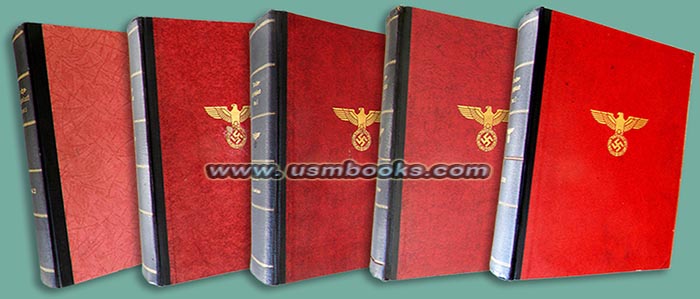The hardbound book offered for sale on this USMBOOKS web page is a rare original example of the Reichsgesetzblatt containing laws and by-laws, ordinances, Hitler decrees, treaties, budgets, amendments to existing laws, etc. for the year 1942. The huge 8-1/2 x 11-5/8 inch 850+ page, 4-1/4 pound hardbound red cover book has gold blocking on the spine and is in very nice condition.
 |
| The Reichsgesetzblatt was the official illustrated publication containing announcements of new laws and amendments of existing laws in Adolf Hitler’s National Socialist Germany, as published by the Reichsministerium des Innern (Interior Ministry) and printed by the Reichsverlagsamt in Berlin. The huge annual or semi-annual publications contained laws and by-laws, ordinances, Hitler decrees, treaties, budgets, amendments to existing laws, and so on. The minutia in these books is incredible! During the Third Reich the Reichsgesetzblatt was published in two editions, Teil 1 and Teil 2, with Part 2 containing international agreements, traffic laws (railroad, shipping), budgets, parliamentary matters, financial matters of the Reichsbank, and Part 1 all other matters. The last edition of the Reichsgesetzblatt was published in early April 1945. The Reichsgesetzblatt is invaluable to anyone involved in research regarding the Third Reich in general, Third Reich law, and the process by which proposed laws became law in Nazi Germany and territories incorporated or occupied by German Armed Forces. |

There are Führer decrees about the newly created position of Generalinspektor für das Kraftfahrwesen (below, SS-Standantenfuehrer Jakob Werlin) and State Secretary for Security in the Generalgouvernement, changes to the leadership of the Nazi Party Chancellery, the national budget, protection of the armament industry, administration in the Protectorate of Bohemia and Moravia, public health and dental care, the legal status of the NSDAP, and building projects in Salzburg, Munich, Nürnberg, Berlin, Wien, Breslau, Oldenburg and Bremen.
This 1-3/4 inch thick edition of the Reichsgesetzblatt also has new ordinances about the cancellation of the clothing subsidy fund for the border police (part of the Gestapo), 9th addition to the law for trade in wallpaper, promotion for members of the RAD that died during the war, railway traffic, adjustment of the law regarding disappearance, date and time of death, war economy measures, RAD service during the war, medicine rationing, war damage in the civilian population, camouflage additions to the existing Luftschutz law, accident insurance, professional restrictions for gypsies, the legality of Jewish cultural clubs, rent subsidies, the incorporation of the Robert Koch Institute into the Reich, changes to the ordinance of the War Merit pennant, social insurance for chimney sweepers and retired miners, railway signals and signs, changes to the midwife law, additions to the ordinance about Amtsschilder (official public signs), short-term service in the Luftwaffe, changes and additions to existing social security and insurance for members of the Wehrmacht and their dependents, user taxes, Mutterschutzgesetz (Law to Protect Employed Mothers), supplements to the carrier pigeon laws, the laws pertaining to the Ostmedaille, Cholmschild and Krimschild, telegram and telegraph traffic, the right to medical care for civilians, customs formalities, dissolution of trade unions in Memel, Danzig and the occupied eastern provinces, as well as Eupen, Malmédy and Moresnet, citizenship revocation, legal responsibilities of SS and Police in the Memelland, care for children of members of the Wehrmacht serving in German occupied territories, decentralization of the administration of the Sicherheitspolizei, accident insurance laws, expansion of the use of Jewish assets, German citizenship in Luxembourg and Alsace Lorraine, modified food, the buying and selling uniforms, aid for TB patients, laws for civil servants working for the police, German citizenship in Eupen, Malmédy and Moresnet, penal code for breaking morality laws in the Protectorate of Bohemia and Moravia, rental agreements, patent protection, Daylight Savings Time, education in public schools in the Sudetenland, the expansion of treason regulations, professional infant and childcare homes, public notary fees, prohibition of private packing of dental powder, car insurance in the Sudetenland, copyright protection for American citizens, the fourth official addition to the lead paint protection ordinance, special income and wealth tax for gypsies, as well as the price regulation of yarn, leather shoes, timber, anesthesia, eggs, milk, vegetables and furniture.
During this year many German laws and ordinances were continued to be introduced in the German Occupied East:
the introduction of laws regarding the prevention of genetic diseases, hospitality laws, hunting and fishing laws, additions to the criminal justice laws for Poles and Jews, German citizenship, legal arbitration, captured foreign assets, labor and railway laws, public film theaters, tax regulation for non ethnic Germans, employment of Jews in important economic jobs, and more. Most people (especially TV producers, but even historians) are not even aware that employment of Jews in Germany during the Third Reich and World War II was allowed and dealt with in a very business-like manner if the Jews so employed possessed a trade or special skill the German government needed. An example is Jews that were employed during WW2 in Berlin in industries such as the assembly of aircraft instruments and other electronic equipment.
the introduction of laws regarding the prevention of genetic diseases, hospitality laws, hunting and fishing laws, additions to the criminal justice laws for Poles and Jews, German citizenship, legal arbitration, captured foreign assets, labor and railway laws, public film theaters, tax regulation for non ethnic Germans, employment of Jews in important economic jobs, and more. Most people (especially TV producers, but even historians) are not even aware that employment of Jews in Germany during the Third Reich and World War II was allowed and dealt with in a very business-like manner if the Jews so employed possessed a trade or special skill the German government needed. An example is Jews that were employed during WW2 in Berlin in industries such as the assembly of aircraft instruments and other electronic equipment.
Also covered are new police ordinances regarding public dancing and other entertainment during war time, the rationing of female hormones and other medication such as codeine and morphine, the prohibition against photography of facilities of national importance, storage of of weapons and ammunition, public (nude) bathing, the use of vehicles with gas generators, bird flu, foreign tourism, and the prevention of Brucellosis.
Page 34 has corrections and there are color pictures of new enamel Nazi signs, and black & white examples of salary and tax tables. A previous owner added some pencil annotations but also official 20 x 20 mm red and white correction / addition / change stickers to many paragraphs throughout this 79 year old Reichsgesetzblatt.
This rare war-time Third Reich law books is in very nice used condition with a tight spine, and has no offensive odor.
Page 34 has corrections and there are color pictures of new enamel Nazi signs, and black & white examples of salary and tax tables. A previous owner added some pencil annotations but also official 20 x 20 mm red and white correction / addition / change stickers to many paragraphs throughout this 79 year old Reichsgesetzblatt.
This rare war-time Third Reich law books is in very nice used condition with a tight spine, and has no offensive odor.
Have a look at other examples of the Reichsgesetzblatt for sale on USMBOOKS.com |
|||||
We are happy to combine shipping of multiple purchases! |
|||||
PLEASE NOTE: due to a lack of time and manpower we are UNABLE to answer questions about or look up specific laws, ordinances, regulations, decrees, etc.
** SOLD ** USM book #1167 |
| • IF you prefer faster and safer Priority Mail shipping with USPS Tracking add $15.50. |
| • IF you wish to purchase highly recommended, but optional insurance, add $4.75. |
| • We will be happy to ship abroad at additional cost, however foreign customers are responsible for any VAT payments, import duties & customs clearing fees. Please inquire. |
REICHSGESETZBLATT - OFFICIAL LEGAL PUBLICATIONS OF THE THIRD REICH, HARDBOUND IN A BOOK
REICHSGESETZBLATT
PART 1 OF 1942

